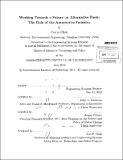| dc.contributor.advisor | Jerry A. Hausman and Sergey Paltsev. | en_US |
| dc.contributor.author | Chen, Cuicui | en_US |
| dc.contributor.other | Massachusetts Institute of Technology. Technology and Policy Program. | en_US |
| dc.date.accessioned | 2012-09-13T18:58:52Z | |
| dc.date.available | 2012-09-13T18:58:52Z | |
| dc.date.copyright | 2012 | en_US |
| dc.date.issued | 2012 | en_US |
| dc.identifier.uri | http://hdl.handle.net/1721.1/72879 | |
| dc.description | Thesis (S.M. in Technology and Policy)-- Massachusetts Institute of Technology, Engineering Systems Division, Technology and Policy Program, 2012. | en_US |
| dc.description | Cataloged from PDF version of thesis. | en_US |
| dc.description | Includes bibliographical references (p. 81-84). | en_US |
| dc.description.abstract | Complementarity of vehicles and fuels has posed significant barrier for increasing the use of alternative fuels in place of traditional ones. An initial positive number of either alternative fuel vehicle (AFV) users or alternative fueling stations are needed for the diffusion of both. This research examines the incentive of the automotive industry, in particular automobile companies focusing on AFVs, to create a positive number of AFV users by demand-side promotion which increases environmental awareness of consumers, and a positive number of alternative fueling stations by supply-side promotion including funding part of the upfront or operating costs of alternative fueling stations. I first build a static microeconomic model of the vehicle and fuel market and find that the demand-side promotion is helpful in creating a positive number of AFVs and alternative fueling stations under a wider range of situations than is supply-side promotion. AFV companies are found to have incentive to do these promotions given affordable promotion costs. Furthermore, using data on vehicle purchase and characteristics of U.S. consumer units from 2005 to 2010 merged with information on state-level fuel prices, fueling stations, and designation of clean cities, I find that the addition of 1 clean city or 100 refueling stations of E85, an alternative fuel used in flex-fuel vehicles, is equivalent to a reduction of $0.04 or $0.19 in the E85 price on the effect of increasing flex-fuel vehicle choice probability respectively. Both the theoretical and empirical results suggest that AFV companies evaluate business opportunities in supply- and demand-side promotions, and that policy makers consider potential contributions of the market to bringing about a future on alternative fuels. | en_US |
| dc.description.statementofresponsibility | by Cuicui Chen. | en_US |
| dc.format.extent | 84 p. | en_US |
| dc.language.iso | eng | en_US |
| dc.publisher | Massachusetts Institute of Technology | en_US |
| dc.rights | M.I.T. theses are protected by
copyright. They may be viewed from this source for any purpose, but
reproduction or distribution in any format is prohibited without written
permission. See provided URL for inquiries about permission. | en_US |
| dc.rights.uri | http://dspace.mit.edu/handle/1721.1/7582 | en_US |
| dc.subject | Engineering Systems Division. | en_US |
| dc.subject | Technology and Policy Program. | en_US |
| dc.title | Working towards a future on alternative fuels : the role of the automotive industry | en_US |
| dc.type | Thesis | en_US |
| dc.description.degree | S.M.in Technology and Policy | en_US |
| dc.contributor.department | Massachusetts Institute of Technology. Engineering Systems Division | |
| dc.contributor.department | Technology and Policy Program | |
| dc.identifier.oclc | 808377087 | en_US |
